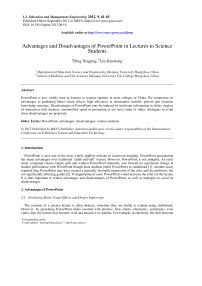Advantages and Disadvantages of PowerPoint in Lectures to Science Students
Автор: Ding Xingeng, Liu Jianxiang
Журнал: International Journal of Education and Management Engineering(IJEME) @ijeme
Статья в выпуске: 9 vol.2, 2012 года.
Бесплатный доступ
PowerPoint is now widely used in lectures to science students in most colleges of China. We summarize its advantages as producing better visual effects, high efficiency in information transfer, precise and systemic knowledge structure. Disadvantages of PowerPoint may be induced by irrelevant information in slides, neglect of interaction with students, uncontrolled speed in presenting or too strict order of slides. Strategies to avoid these disadvantages are proposed.
PowerPoint, advantages, disadvantages, science students
Короткий адрес: https://sciup.org/15013753
IDR: 15013753
Список литературы Advantages and Disadvantages of PowerPoint in Lectures to Science Students
- L. Daniels, ―Introducing technology in the classroom: PowerPoint as a first step,‖ J. Comput. High Educ., vol. 10, pp. 42-56, March 1999.
- J. M. Apperson, E. L. Laws and J. A. Scepansky, ―An assessment of student preferences for PowerPoint presentation structure in undergraduate courses,‖ Comput. Educ., vol. 50, pp. 148–153, January 2008.
- R. B. Lowry, ―Electronic presentation of lectures—effect upon student performance,‖ U. Chem. Ed., vol. 3, pp. 18–21, April 1999.
- L. J. ChanLin, ―Attributes of animation for learning scientific knowledge,‖ J. Instr. Psychol., vol. 27, pp. 228–238, December 2000.
- A. Szabo and N. Hastings, ―Using IT in the undergraduate classroom: should we replace the chalkboard with PowerPoint?‖ Comput. Educ., vol. 35, pp. 175-187, November 2000.
- K. A. Babb and C. Ross, ―The timing of online lecture slide availability and its effect on attendance, participation, and exam performance,‖ Comput. Educ., vol. 52, pp. 868–881, May 2009.
- J. M. Tangen, M. D. Constable, E. Durrant, C. Teeter, B. R. Beston, and J. A. Kim, ―The role of interest and images in slideware presentations,‖ Comput. Educ., in press.
- R. A. Bartsch and K. M. Cobern, ―Effectiveness of PowerPoint presentations in lectures,‖ Comput. Educ., vol. 41, pp. 77–86, August 2003.
- D. A. Slykhuis, E. N. Wiebe, and L. A. Annetta, ―Eye-tracking students’ attention to PowerPoint photographs in a science education setting,‖ J. Sci. Educ. Tech., vol. 14, pp. 509-520, December 2005.
- M. Canham and M. Hegarty. ―Effects of knowledge and display design on comprehension of complex graphics,‖ Learn. Instr., vol. 20, pp.155-166, April 2010.
- R. Moreno and R. E. Mayer, ―A coherence effect in multimedia learning: the case for minimizing irrelevant sounds in the design of multimedia instructional messages,‖ J. Educ. Psychol., vol. 92, pp. 117–125, March 2000.
- R. E. Mayer, E. Griffith, I. T. N. Jurkowitz, and D. Rothman, ―Increased Interestingness of Extraneous Details in a Multimedia Science Presentation Leads to Decreased Learning,‖ J Exp. Psychol. Appl., vol. 14, pp. 329-339, December 2008.
- R. E. Mayer, Multimedia Learning. Camdridge, UK: Cambridge University Press, 2001.
- A. Savoy, R. W. Proctor, and G. Salvendy, ―Information retention from PowerPoint and traditional lectures,‖ Comput. Educ., vol. 52, pp. 858–867, November 2009.
- J. Holzl, ―Twelve tips for effective PowerPoint presentations for the technologically challenged,‖ Med. Teach., vol. 19, pp. 175-179, January 1997.
- D. D. Howell, ―Four key keys to powerful presentations in PowerPoint: take your presentations to the next level,‖ Tech. Trends, vol. 52, pp. 44-46, November/December 2008.
- T. L. P. Tang and M. J. Austin, ―Students’ perceptions of teaching technologies, application of technologies, and academic performance,‖ Comput. Educ., vol. 53, pp. 1241-1255, December 2009.
- J. E. Stephenson, C. Brown, and D. K. Griffin, ―Electronic delivery of lectures in the university environment: An empirical comparison of three delivery styles,‖ Comput. Educ., vol. 50, pp. 640–651, April 2008.


